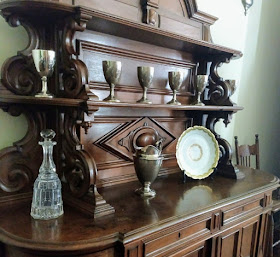Catherine, the Hammond album quilt and the panel wreath
repeated in the quilt blocks.
Finding out more about this panel quilt is how this search got started.
The house at Redcliffe plantation, mid-20th-century
In Catherine's day there were more piazzas and porches.
The house at Redcliffe has been restored.
The nearest town of any size was Augusta, Georgia, about 12 miles away.
Husband James Henry Hammond had made a name for himself with his pro-Southern oratory before he quit the U.S. Senate when Lincoln was elected, asserting in 1858 that the South's economy made the region immune to threats to end slavery.
"You dare not make war upon cotton! No power on earth dares make war upon it. Cotton is king."
Southern states head off a cliff yelling "Cotton is King."
Cartoon from the Library of Congress
Hammond was wrong about many things but after a 5-year separation in the early 1850s Catherine stuck with him for the rest of his life. When the war began they had three sons in their twenties, James Henry II (called Harry), Paul, and Edward (called by his middle name Spann). Three daughters in their teens and early twenties lived at home.
1860 Census
Did infant Claude, born when Catherine was in her mid 40s, die so young he's almost forgotten now?
The 1860 slave schedules list 50 people living at Redcliffe but hundreds more worked at their larger plantations.
Harry was quartermaster in Gregg's Brigade throughout the war.
James Hammond was not only a "tough son-of-a-bitch" as biographer Carol Bleser called him, he was a classic egomaniac, viewing war's demands as inconveniences to his plantation management and insisting his sons stay home rather than join the Confederate armies. Eldest son Harry defied him by quitting his position as a geology professor at the University of Georgia to join the South Carolina Infantry. Paul joined Edwin Kirby Smith's troops where he was an aide to the General and Spann enlisted for a six-months commitment.
Once a draft was enacted substitutes were available North and South
Paul Fitzsimons Hammond (1838-1887)
After six months Spann's wife's family bought him a substitute and he farmed his own plantations for the rest of the war. Paul likewise served a short term until his father paid a substitute $1,100 to replace him.
Northern view of Southern conscription
Paul D. Escott estimates that Southern elites hired 50,000 to 150,000 men to serve as alternates (an expense only the elite could afford.) He quotes the Richmond Enquirer as noting the ability to pay a substitute was proof of a man's "social and industrial value." The aristocrats' lives "were more important than the lives of the poor."
Major Harry Hammond (1832-1916)
Despite an old injury that left one leg shorter than the other, Hammond served throughout the war as a quartermaster, supervising supplies. He lived to surrender at Appomattox Court House with the Army of Northern Virginia.
Virginia Clay Clopton (1825-1915)
published her rosy memoir A Belle of the Fifties in 1904.
Virginia Clay Clopton, cousin to Mary Louisa (Loula) Comer who married Catherine's son Paul, spent time during the war as a refugee at Redcliffe. Her memoir, which has far too many references to the "well-fed, plump and happy coloured people" enslaved at Redcliffe, also recalls the common story of hiding the silver from approaching Union troops towards the end of the war.
"Declaring to those of the servants who stood about as we entered the carriage, that we were taking some provisions to Mrs. Redd. ...we dispensed with a coachman, and drove off. We had many a laugh as we proceeded through the woods, at our absurdity in concealing our errand from the family servants....When we had driven a mile or more, Mr. Tunstall produced a hatchet and began to blaze [notch] the trees.... after instructing us as to the signs he had made, 'when you come to where the blaze stops, you'll find your valuables!' and under his directions the silver was silently sunk in the ground and the earth replaced."
Silver at Redcliffe today
Loula Hammond remembered, "It was months before we succeeded in finding the silver again. Though we dug the ground over and over in every direction where we thought it was, we couldn't even find the blazes for a long time."
Catherine's husband James's obsession with his own health continued through the war. Addicted to drugs, treated with poisonous mercury and chronically anxious, Hammond spent much time as an invalid. Digestive problems he blamed on a "defective nervous system" increased while bleeding was a symptom of something actually seriously wrong. Cancer? Inflammation like Crohn's Disease? Liver failure?
Catherine's husband James's obsession with his own health continued through the war. Addicted to drugs, treated with poisonous mercury and chronically anxious, Hammond spent much time as an invalid. Digestive problems he blamed on a "defective nervous system" increased while bleeding was a symptom of something actually seriously wrong. Cancer? Inflammation like Crohn's Disease? Liver failure?
Bedroom at Redcliffe today
"Quite unwell myself-have not for some time slept well of nights. The War, the impressment, & Sickness here, & altogether too much to do, have altogether used me up." Hammond's diary three months before he died.
Hammond declined until a fatal hemorrhage in November, 1864 a few months before war's end. Spann believed he willed himself to die or perhaps took a deliberate drug overdose to deliver him from his increasingly hostile world.
Catherine soldiered on. Hammond's Southern identity allowed no hedging of his bets so their considerable cash assets had been invested in Confederate bonds. She inherited Redcliffe and managed it until 1873 when she sold it to son Harry.
The 1880 census lists her as a 66-year-old farmer living with a niece and a granddaughter.
Harry and Catherine could only watch their real estate sink into late-19th-century disrepair, but he continued his interests in the sciences and agriculture, publishing statistical analyses that earned him a reputation.
Catherine's extended family left an enormous amount of paper, yet who she really was remains elusive. A glimpse of how she survived a miserable marriage to a miserable man in miserable times and created a sturdy bunch of descendants is in one letter she wrote to her brother-in-law soon after the war. She acknowledges she could, “scarce restrain a burst of complaint at my change in circumstances—but as I compare my lot with many others, I see only cause for thankfulness."
Catherine died in 1896
Her letter goes on:
"I hope you will save all Mr Hammond's letters."
https://southcarolinaparks.com/redcliffe
More about the Hammonds:
There are classic American families that when followed through the generations tell us much about our history. The Hammonds are a great example. They wrote and kept records; they stashed them in the attics and eventually a descendant with money and curiosity saved it all---the house, the account books and diaries, the letters. John Shaw Billings was editor at Time and Life magazines. His retirement allowed him time to preserve the family legacy. Family papers are now in the South Caroliniana collection at the University of South Carolina (Hammond-Bryan-Cumming collection.) Historian Carol Rothrock Bleser spent years editing those papers. Some of her books:
Tokens of Affection: The Letters of a Planter’s Daughter in the Old South (1996)
The Hammonds of Redcliffe (1981)
Secret and Sacred: The Diaries of James Henry Hammond, a Southern Slaveholder (1988).
Carol K. Rothrock Bleser
Here's her 2013 obituary:
Google book preview here:
https://books.google.com/books?id=AGs5adK1R6YC&printsec=frontcover&source=gbs_ge_summary_r&cad=0#v=onepage&q&f=false
Go to the South Carolina Digital Library
Go to the South Carolina Digital Library
https://scmemory.org/
Do a search for Hammond.
Do a search for Hammond.
Other references:
Virginia Clay Clopton: A Belle of the Fifties: Memoirs of Mrs. Clay, of Alabama, Covering Social and Political Life in Washington and the South, 1853-66. One can compare memory to reality as seen in the Hammond papers and their analysis.
Paul D. Escott. The Confederacy: The Slaveholders' Failed Venture
And see another quilt with a Hammond family connection, linked to Catherine Hammond's daughter Katherine Hammond Gregg:


















This was so very interesting. I enjoy your history very much. I had no idea you could put someone else in your place to fight. I know that a conscientious objector could pay some money not to fight. I can’t remember the amount. It’s nice to leave letter and info about the past. Thank you so much.
ReplyDeleteGood Morning! I enjoyed this very much. I just wanted to say that my family, the Orrs, are originally from the western side of North Carolina, near Asheville. They were not rich or elite at all, they were non-slave owning farmers, yet my great grandfather also paid someone to fight in his place, and nowhere near $1,1000. And yet the war destroyed the economy of the South so much they ended up going to Washington Territory in the 1880s. my grandfather, born in 1889 liked to brag that he was "conceived in North Carolina and born in Washington Territory!" It became a state a few months after his birth in 1889. I was born in Washington State in 1953.
ReplyDeleteThank you for all the historical research you do.
Another super post - took a while to slowly peruse it all. Love the families history - even if it is tainted by one member - adds to the drama! Many thanks.
ReplyDeleteDon't forget the horses fabric from Andover. Like the dogs and bunnies, comes in 3 color ways. Moda's Redwork Garden also has white bees or birds on red background. 19th Century conversational repros are rare, grab them while you can.
ReplyDelete